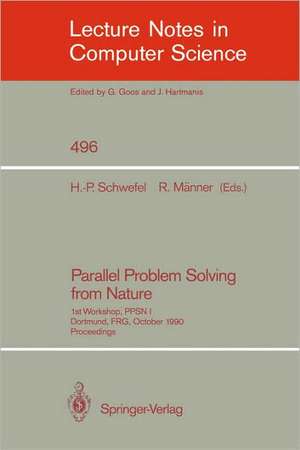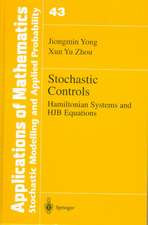Parallel Problem Solving from Nature: 1st Workshop, PPSN I Dortmund, FRG, October 1-3, 1990. Proceedings: Lecture Notes in Computer Science, cartea 496
Editat de Hans-Paul Schwefel, Reinhard Männeren Limba Engleză Paperback – 12 iun 1991
Din seria Lecture Notes in Computer Science
- 20%
 Preț: 1061.55 lei
Preț: 1061.55 lei - 20%
 Preț: 307.71 lei
Preț: 307.71 lei - 20%
 Preț: 438.69 lei
Preț: 438.69 lei - 20%
 Preț: 645.28 lei
Preț: 645.28 lei -
 Preț: 410.88 lei
Preț: 410.88 lei - 15%
 Preț: 580.46 lei
Preț: 580.46 lei - 17%
 Preț: 427.22 lei
Preț: 427.22 lei - 20%
 Preț: 596.46 lei
Preț: 596.46 lei -
 Preț: 449.57 lei
Preț: 449.57 lei - 20%
 Preț: 353.50 lei
Preț: 353.50 lei - 20%
 Preț: 1414.79 lei
Preț: 1414.79 lei - 20%
 Preț: 309.90 lei
Preț: 309.90 lei - 20%
 Preț: 583.40 lei
Preț: 583.40 lei - 20%
 Preț: 1075.26 lei
Preț: 1075.26 lei - 20%
 Preț: 310.26 lei
Preț: 310.26 lei - 20%
 Preț: 655.02 lei
Preț: 655.02 lei - 20%
 Preț: 580.93 lei
Preț: 580.93 lei - 20%
 Preț: 340.32 lei
Preț: 340.32 lei - 18%
 Preț: 938.83 lei
Preț: 938.83 lei - 20%
 Preț: 591.51 lei
Preț: 591.51 lei - 15%
 Preț: 438.59 lei
Preț: 438.59 lei - 20%
 Preț: 337.00 lei
Preț: 337.00 lei -
 Preț: 389.48 lei
Preț: 389.48 lei - 20%
 Preț: 607.39 lei
Preț: 607.39 lei - 20%
 Preț: 1024.44 lei
Preț: 1024.44 lei - 20%
 Preț: 579.30 lei
Preț: 579.30 lei - 20%
 Preț: 763.23 lei
Preț: 763.23 lei - 20%
 Preț: 453.32 lei
Preț: 453.32 lei - 20%
 Preț: 575.48 lei
Preț: 575.48 lei - 20%
 Preț: 585.88 lei
Preț: 585.88 lei - 20%
 Preț: 825.93 lei
Preț: 825.93 lei - 20%
 Preț: 763.23 lei
Preț: 763.23 lei - 17%
 Preț: 360.19 lei
Preț: 360.19 lei - 20%
 Preț: 1183.14 lei
Preț: 1183.14 lei - 20%
 Preț: 340.32 lei
Preț: 340.32 lei - 20%
 Preț: 504.57 lei
Preț: 504.57 lei - 20%
 Preț: 369.12 lei
Preț: 369.12 lei - 20%
 Preț: 583.40 lei
Preț: 583.40 lei - 20%
 Preț: 343.62 lei
Preț: 343.62 lei - 20%
 Preț: 350.21 lei
Preț: 350.21 lei - 20%
 Preț: 764.89 lei
Preț: 764.89 lei - 20%
 Preț: 583.40 lei
Preț: 583.40 lei - 20%
 Preț: 649.49 lei
Preț: 649.49 lei - 20%
 Preț: 341.95 lei
Preț: 341.95 lei - 20%
 Preț: 238.01 lei
Preț: 238.01 lei - 20%
 Preț: 538.29 lei
Preț: 538.29 lei
Preț: 400.10 lei
Nou
Puncte Express: 600
Preț estimativ în valută:
76.56€ • 80.20$ • 63.45£
76.56€ • 80.20$ • 63.45£
Carte tipărită la comandă
Livrare economică 09-23 aprilie
Preluare comenzi: 021 569.72.76
Specificații
ISBN-13: 9783540541486
ISBN-10: 3540541489
Pagini: 504
Ilustrații: XI, 489 p.
Dimensiuni: 155 x 235 x 26 mm
Greutate: 0.7 kg
Ediția:1991
Editura: Springer Berlin, Heidelberg
Colecția Springer
Seria Lecture Notes in Computer Science
Locul publicării:Berlin, Heidelberg, Germany
ISBN-10: 3540541489
Pagini: 504
Ilustrații: XI, 489 p.
Dimensiuni: 155 x 235 x 26 mm
Greutate: 0.7 kg
Ediția:1991
Editura: Springer Berlin, Heidelberg
Colecția Springer
Seria Lecture Notes in Computer Science
Locul publicării:Berlin, Heidelberg, Germany
Public țintă
ResearchCuprins
Global convergence of genetic algorithms: A markov chain analysis.- The theory of virtual alphabets.- Towards an optimal mutation probability for genetic algorithms.- An alternative Genetic Algorithm.- An analysis of the interacting roles of population size and crossover in genetic algorithms.- Gleam a system for simulated "intuitive learning".- Genetic algorithms and highly constrained problems: The time-table case.- An evolution standing on the design of redundant manipulators.- Redundant coding of an NP-complete problem allows effective Genetic Algorithm search.- Circuit partitioning with genetic algorithms using a coding scheme to preserve the structure of a circuit.- Genetic algorithms, production plan optimisation and scheduling.- System identification using genetic algorithms.- Conformational analysis of DNA using genetic algorithms.- Operator-oriented genetic algorithm and its application to sliding block puzzle problem.- A topology exploiting genetic algorithm to control dynamic systems.- Genetic local search algorithms for the traveling salesman problem.- Genetic programming artificial nervous systems artificial embryos and embryological electronics.- Concept formation and decision tree induction using the genetic programming paradigm.- On solving travelling salesman problems by genetic algorithms.- Genetic algorithms and punctuated equilibria in VLSI.- Implementing the genetic algorithm on transputer based parallel processing systems.- Explicit parallelism of genetic algorithms through population structures.- Parallel genetic packing of rectangles.- Partitioning a graph with a parallel genetic algorithm.- Solving the mapping-problem — Experiences with a genetic algorithm.- Optimization using distributed genetic algorithms.- Application of theEvolutionsstrategie to discrete optimization problems.- A variant of evolution strategies for vector optimization.- Application of evolution strategy in parallel populations.- Global optimization by means of distributed evolution strategies.- Solving sequential games with Boltzmann-learned tactics.- Optimizing simulated annealing.- Parallel Implementations Of Simulated Annealing / A local timing model for parallel optimization with Boltzmann Machines.- Error-free parallel implementation of simulated annealing.- Trimm: A parallel processor for image reconstruction by simulated annealing.- The response-time constraint in neural evolution.- An artificial neural network representation for artificial organisms.- Feature construction for back-propagation.- Improved convergence rate of back-propagation with dynamic adaption of the learning rate.- Performance evaluation of evolutionarily created neural network topologies.- Optical image preprocessing for neural network classifier system.- Gannet: Genetic design of a neural net for face recognition.- The application of a genetic approach as an algorithm for neural networks.- Genetic improvements of feedforward nets for approximating functions.- Exploring adaptive agency III: Simulating the evolution of habituation and sensitization.- A learning strategy for neural networks based on a modified evolutionary strategy.- Genetic algorithms and the immune system.- Selectionist categorization.- A classifier system with integrated genetic operators.- The fuzzy classifier system: Motivations and first results.- Hints for adaptive problem solving gleaned from immune networks.- A reactive robot navigation system based on a fluid dynamics metaphor.- Transfer of natural metaphors to parallel problem solving applications.- Modelling and simulation of distributed evolutionary search processes for function optimization.- Parallel, decentralized spatial mapping for robot navigation and path planning.- Ecological dynamics under different selection rules in distributed and iterated prisoner's dilemma game.- Adaptation in signal spaces.- A principle of minimum complexity in evolution.- The emergence of data structures from local interactions.- The view from the adaptive landscape.- Boltzmann-, Darwin- and Haeckel-strategies in optimization problems.- Optimizing complex problems by nature's algorithms: Simulated annealing and evolution strategy—a comparative study.- Genetic Algorithms and evolution strategies: Similarities and differences.- Building the ultimate machine: The emergence of artificial cognition.














